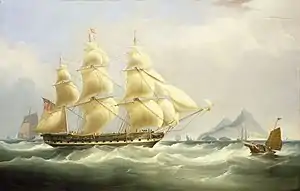William John Huggins
William John Huggins (1781 – 19 May 1845) was a British marine painter who won royal patronage for his work.
Life

Little is known of Huggins' early life. He made one voyage between December 1812 and August 1814 as an ordinary seaman on the East Indiaman Perseverance on her voyage to Bombay and China. During this voyage he made many drawings of ships and landscapes in China and elsewhere. He eventually settled in Leadenhall Street, near East India House in London, England, and practised his art as a profession, being specially employed to make drawings of ships in the company's service. His work, both original and as prints, found a ready market amongst merchants and seamen.
In 1817 Huggins exhibited a picture in the Royal Academy, and continued to exhibit occasionally up to his death. He also exhibited at the British Institution from 1825 onwards. He became a marine-painter to George IV and to William IV - for the latter painting three large pictures of the Battle of Trafalgar.
In about 1805 he married Berthia, their children included: James Miller Huggins (1807–1870), also a marine artist; John William Huggins (1809–?) and Berthia Huggins (1811–1884) who married Edward Duncan and was the mother of Walter Duncan. James and John both contributed to Huggins' Marine Sketches.[1]
Huggins died in Leadenhall Street, London, in May 1845. He was buried on the western side of Highgate Cemetery.
Works
Huggins' nautical knowledge ensured his pictures had some repute as portraits of ships, and, although "weak in colouring and general composition" (according to art historian Lionel Cust), they are regarded as a valuable record of the shipping of the period. Some of his work was engraved.
Gallery
_-_The_Ship_'Delaford'_-_BHC3283_-_Royal_Museums_Greenwich.jpg.webp) The Ship Delaford
The Ship Delaford The East Indiaman Asia
The East Indiaman Asia The topsail schooner Amy Stockdale off Dover
The topsail schooner Amy Stockdale off Dover The Northern Whale Fishery 1835
The Northern Whale Fishery 1835
References
- "James Miller Huggins (Biographical details)". The British Museum. Retrieved 23 November 2015.
- Nicholas, Tracy. Britannia's palette: the arts of naval victory (McGill-Queen's University Press, 2007) p. 329 ff.
- Attribution
 This article incorporates text from a publication now in the public domain: "Huggins, William John". Dictionary of National Biography. London: Smith, Elder & Co. 1885–1900.
This article incorporates text from a publication now in the public domain: "Huggins, William John". Dictionary of National Biography. London: Smith, Elder & Co. 1885–1900.
External links
- Huggins biography and paintings (National Maritime Museum, London)
- Huggins online (ArtCyclopedia)
- 40 artworks by or after William John Huggins at the Art UK site. Works in British public collections.